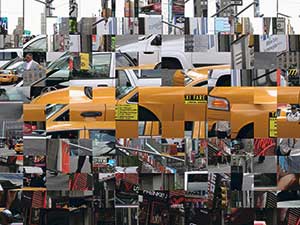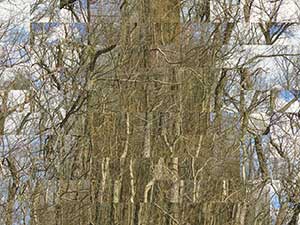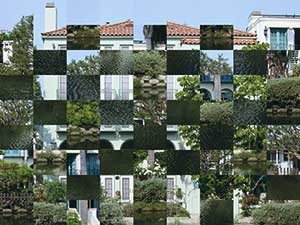


STATEMENT 6
Alongside human civilization's great achievements in art, philosophy, and the sciences, must also be placed the facts of what humans have done to the planet. We have wrought immeasurable destructions to the land, to the oceans, to the air. Thousands of species go extinct each year. We have reshaped our environs not even mostly by pursuing the simple narcissism of redesigns we find appealing, but rather by taking whatever most efficiently provides for our consumptive desires: mountaintops are removed, meadows are paved over, coral reefs destroyed. All these are crimes committed without an artist's even cursory consideration of the final images that will result, and almost no one has held back; we deny ourselves nothing out of consideration for the future of our planet, or even of our species. Few take the mental leap outside of our human framework that might allow one to try to view the planet from the perspective of the entities that we are destroying. But it is only from what we might imagine to be the point of view of an animal, or an insect, or a rock, that we can even begin to consider what we have done, and what we continue to do in ever-escalating ways. Wilderness trips I took alone in the north woods, mostly in Canada, decades ago were formative, and remain a deep source of inspiration. Though drinking water I found there, and also using the locales for my pleasure, I was not seeking to alter or dominate, and I learned on these trips an expansive, non-possessive way of seeing: each image of a scene I walk to is tied to every other image seen on the walk, to images of things ahead and behind, to things just seen and things that were seen yesterday and things that will be seen tomorrow. The view from a lake, or a hill, that one has arrived at by machine may be optically identical to the same view reached on foot, but their effects are utterly different. In a walk, time, space, body movements, and the air are all interwoven with imagery. Looking back at a valley just traversed, instead of a static image I see the points that led me to my present position, the many steps of my walk. By extrapolation, every image can be both understood and deeply felt as a part of larger entities, inextricably linked to huger fields. A stream is not just a ribbon of water, but is fed by and a product of rain falling on the land around it, and it flows to the lake I will swim in, and ultimately into the sea. But I used machines to get to my starting points, and thus, like the rest of us, participated in the grinding up of nature to suit our selfish purposes. The question then arises as to whether there is not a fundamental defect in human thought. Have the precise logic and reasoning of even the greatest scientists and philosophers helped lead to the filling up of our oceans with plastic? Does the kind of thinking that compares appearances, measures sizes, parses things for their characteristics, and ultimately values one object over another, making selections based on superficial but quantifiable characteristics such as attractiveness and strength, or even merely color and shape, have deeper roots in the structures of our thought, language, even eyesight? The self-enclosed, constructed worlds of even the very greatest art offer sensory and intellectual gratifications on the highest level, resonating between their parts, but are they also, in some inarticulable way, based on such principles that, leading to the creation of artificial orderings, partake of some of the same ideology that transforms wilderness into wastes? Could it be that what is missing is some fundamental act of beyond-our-species empathy, a willingness to try to relocate our seeing in perspectives other than our own?
Any human who imagines that it's possible to escape thought patterns that have characterized our civilization since its inception would be possessed by extreme hubris, but perhaps, in the most modest of ways, we can try to understand the implications of what we have done, develop critiques of past thinking, and begin to take small steps toward imagining alternatives. Is it possible for a human to construct art works that critique the aggression that lies beneath all our image-making aspirations, from the simple act of "shooting" a picture to our drive to reshape images according to the contours of our own desires? When I take a photograph, its composition unquestionably reflects my particular ways of seeing, themselves inflected by my preferences and biases. In the Grids portion of Quarries, however, I chop up my image into pre-determined grids, varying between two by two and thirteen by thirteen cells, and then rearrange all the cells of each grid, all the image's parts, into new patterns using random numbers. It is hoped that the result is not ruled by any one individual's subjectivity, but rather, reflects the widest possible range of ways of reframing and rearranging and interrelating the parts of an image - and the objects of the world. My cell combinations may sometimes seem to bunch similar cells together, or to clash, but I hope that the hints of innumerable connections that these rearrangements reveal render traditional ideas of pleasing aesthetic arrangements less apposite. For the Quarries, Figmented, the many and varied reductions in resolution of the parts of a single image, also created with a controlled use of random numbers and repeated nine times in different ways within a single work, not only reveal the innards of digital imaging but suggest the arbitrariness of all image making, something that should become evident as the viewer compares the same parts of the image in these nine renderings. For the Remade works of Quarries, each of which is a diptych, I first construct a grid making no use of randomness, which becomes the smaller panel, and then repeat the grid nine times in the larger panel, reducing most cells in resolution by varying degrees and in different patterns in each of the nine in a manner analogous to that of the Quarries, Figmented. In constructing some of these grids, I seek traditional forms of balance between parts, but in others I make extremely artificial, even almost humorously so, designs. One metaphor I think about for these is the absurd arrangements some of us make, often unconsciously, in our daily lives, such as ordering books solely by jacket color. In my grids, the trees in a forest become a single tree; power lines swirl about an empty center; small fragments of Times Square are rearranged into bands of similar colors. These synthetic reorderings reflect on, and perhaps parody, the larger human endeavor to bring order and understanding to our incomprehensible universe: we construct arbitrary systems; invent myths and religions; create art works that reflect our tastes; discover scientific formulas that predict much but explain nothing. My artificial grids suggest that all our human understandings are manufactured confections, arbitrary, incomplete, and sometimes even, if seen from the widest possible of perspectives, more than a little ridiculous. They can have great power, but they can also be destructive, much more than we would like to admit, of our attempts to perceive the world that stands before us, and the thinking that they encourage can lead to our destruction of that world in actuality as well, a fact we could better understand if we could only cast the blinding veil of our self-centeredness away from our eyes.
Fred Camper
Chicago, Illinois
August 18, 2010.